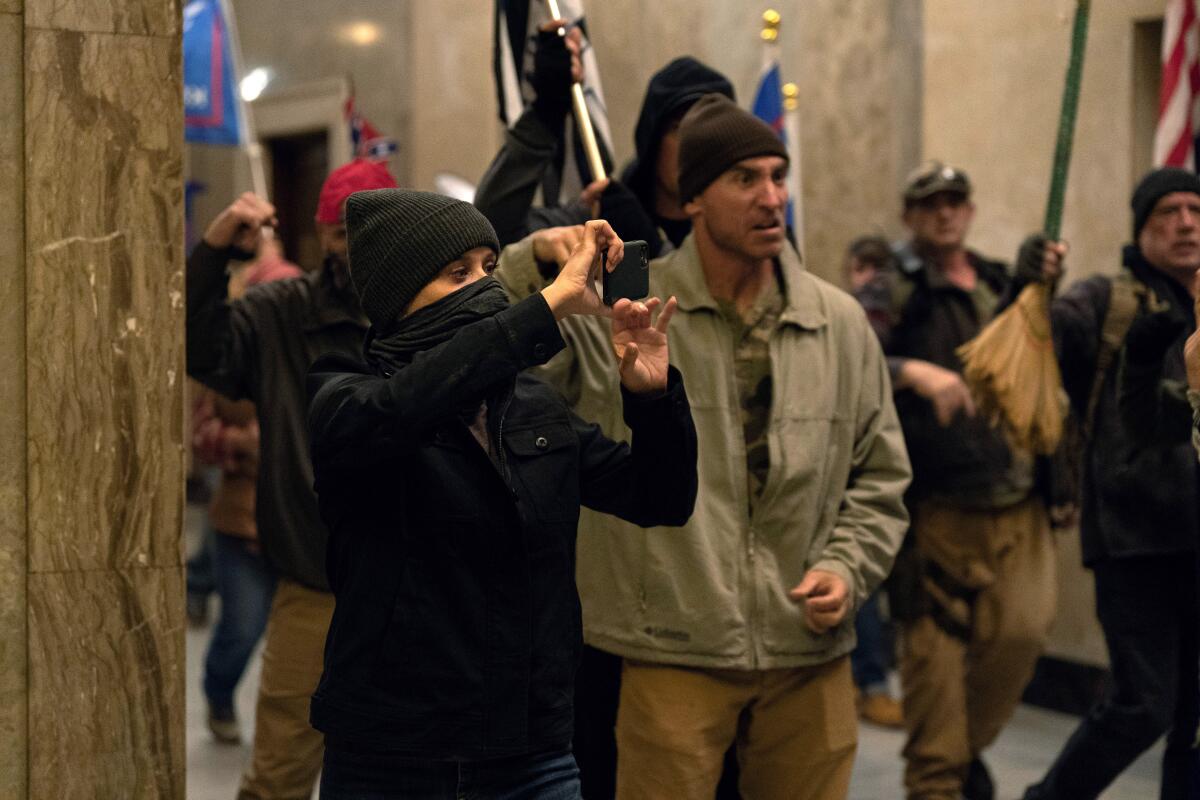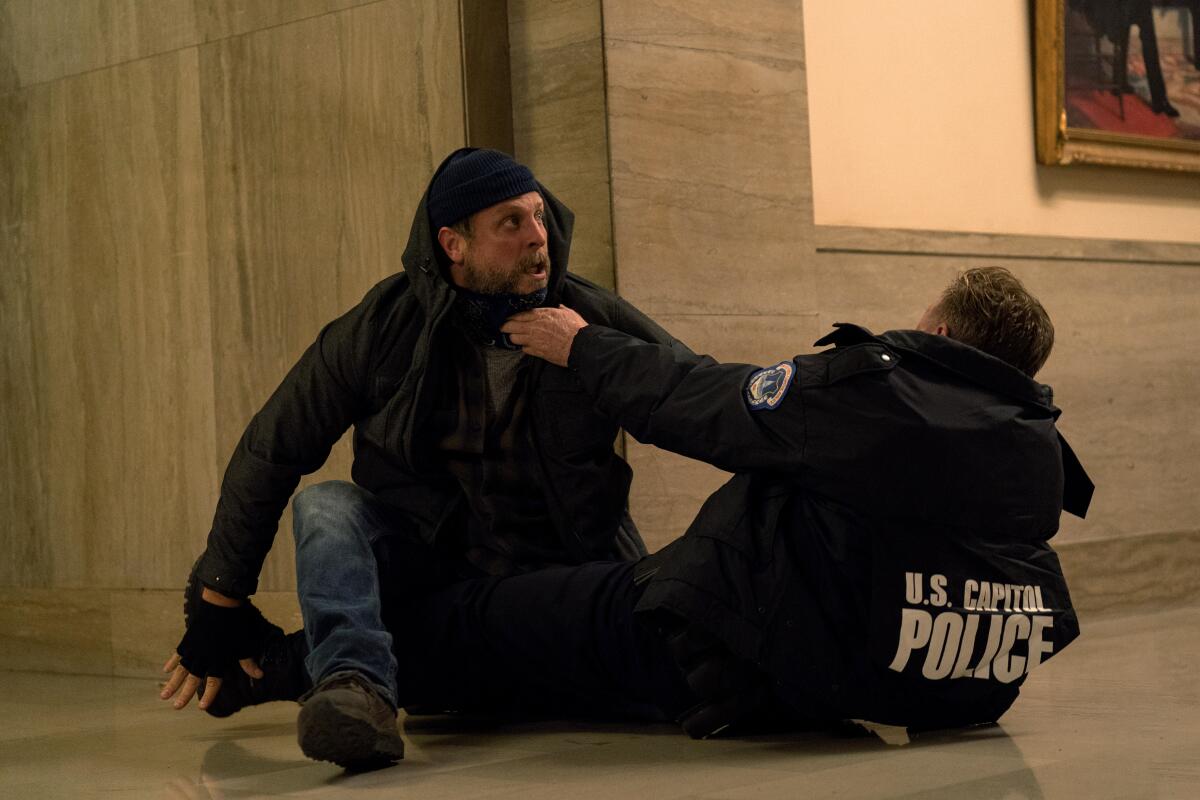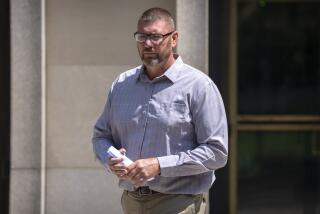How ‘The Morning Show’ re-created the Jan. 6 insurrection, leading to Bradley’s big lie

- Share via
This article contains spoilers for Episode 5 of Season 3 of “The Morning Show.”
Drawing from real-world news headlines is baked into the premise of “The Morning Show,” AppleTV+’s drama about the behind-the-scenes machinations of a popular daytime news program and the lives of its anchors and leaders of the fictional network, UBA. The #MeToo movement, the 2017 Las Vegas shooting, and the COVID-19 pandemic are just some of the events that have served as backdrops to the dilemmas afflicting the show’s characters. Now, the series is among the first to dramatize the violent attack on the U.S. Capitol on Jan. 6, 2021.
The series returned last month for its third season with a time jump to March 2022, two years after the events of the Season 2 finale, allowing it to delve into a number of issues, including abortion access after the Supreme Court overturned Roe vs. Wade. And this week’s episode, “Love Island,” goes back in time to fill in the gaps.
Written by Zander Lehmann, the episode chronicles the period from March 2020 to early 2021 and finds Bradley (Reese Witherspoon) out of New York City and in Montana, where she relocated with Laura (Julianna Margulies) to work remotely as the COVID-19 pandemic was taking hold. As Bradley grapples with the fear, anxiety and a sense of isolation during the early days of the pandemic, including processing the death of her mother from the disease, her family’s background and political views become a sore point in her relationship with Laura.
By winter, Bradley heads to Washington in the lead-up to the certification of the presidential vote and, later, becomes the person on the ground covering the insurrection at the Capitol on Jan. 6. While filming the chaos with her phone, she discovers her brother Hal (Joe Tippett) is part of the mob as he assaults a U.S. Capitol police officer. Bradley leveraged her coverage to score the anchor position for the network’s evening news program, but not before deleting footage that could implicate her brother — protecting him, at least for now.
“We like to tell our stories through our characters,” said executive producer Mimi Leder. “Bradley’s big secret this season is hiding the event that her brother was at the insurrection. And it’s the moral question that runs through journalists when they have to tell the truth, and one of the big themes this season is the state of the truth. And I gotta say, I just thought it was the perfect way into her moral dilemma.”

Charlotte Stoudt, who joined as showrunner for Season 3 of the series, said the inspiration for the storyline came after reading about the teenager Jackson Reffitt and the conundrum he faced with his father, Guy Reffitt. Jackson tipped off the FBI about his father’s far-right political extremism on Christmas Eve 2020 and weeks later reported his father for storming the Capitol in support of then-President Donald Trump. (Guy, a member of the Three Percenters, an anti-government militia group, was arrested and sentenced to more than seven years in prison.)
“It’s such a massive event,” said Stoudt in an interview conducted after the Writers Guild of America strike concluded. “And so its implications are so vast that I feel like the only way to sort of come at something like that is very personally. And I was struck over many months ago, when I was following this other story of this kid who felt like he had to call the FBI and report his own father. Imagine doing that as a 17-year-old? To go to the government, [and] say my dad might be committing sedition. What would it be like to be in that situation where you’re so divided within the family?”
Stoudt said that a lawyer who worked with a Jan. 6 defendant, as well as his client, spoke to the writers. In addition to following the testimony from U.S. Capitol Police officers and listening to various podcasts that dove into the events, she said the 2021 HBO documentary “Four Hours at the Capitol,” and the journey of one of the photographers featured in it, prompted useful questions to consider, mainly: What is it like to be that person documenting this? And the character of Bradley felt best suited to grapple with the professional and personal dilemmas it would provoke, she said.
“Early on in the planning of this season, there was the feeling that Bradley had to make a misstep, that she had to overreach — and what would that look like,” Stoudt said. “Bradley is someone who is divided. She is, on some level, living this essentially coastal elite life, but also has roots in a much more rural flyover world — and just what would be the epitome of that split self? What event could best express the dilemma of that divided self? This felt like a way to do a deep dive into that. In the first two seasons, we’ve just seen Bradley be the sort of moral compass for so many people and to have her compass sort of shake a little, I thought it was it was time to see that.”
The re-creation of the events of Jan. 6 are distilled into a two-minute sequence, which features a voiceover of Trump’s “fight like hell” speech. While the episode integrates some exterior footage of the real event, production designer Nelson Coates pored over a trove of video footage and photographic references to determine the key touch points, such as signage and statuaries, to re-create the interior of the U.S. Capitol as it was being stormed. Since the series is shot in Los Angeles, finding a space that carried the scale and marble finishes similar to the Capitol proved challenging. A municipal building was ultimately selected for the interior shots, and the scenes were aided by some visual effects.
“When you’re doing an event for a fictional series, and especially one so amazingly documented from so many different areas — we’re not doing a documentary, we’re doing emotions — and [finding] stylistic ways of how to replicate or have our characters feel and experience something,” he said. “Some of this is, stylistically, broad-stroke: What are the things that even as a visitor, if you go to the Capitol, what do you take away? The majesty, the space, the marble, the arc, the statuary. The emotional center is about our characters, but the environment has to tell that same story.”
Stacie Passon, who directed the episode, had roughly three hours to shoot the sequence, which required a camera operator with a handheld long lens walking down two flights of stairs backwards while also maneuvering through the crowd. Passon said she wanted to stay away from archetypes from the day, such as the man sporting a Viking helmet and fur vest, while still presenting a depiction that evoked the lasting visuals of the day.
“It was a sight to behold,” Passon said. “How do you create something that’s so ugly and messy in a big, glossy, fizzy show? But Zander really accounted for that because he had scripted a lot of isolation [because of] the pandemic. That created an opportunity for us to really shoot something very, very pared down in the first third or half of the episode. And as the paranoia and isolation kind of creep in, we feel the tension building. When we get to Jan. 6, all that isolation, we bust out of it, and we can now see something more jarring. It can be really messy, and and ugly, because there’s no version of this that wasn’t ugly.”
Bradley’s ethical breach later poses a problem when the FBI issues a subpoena for the footage to help determine who assaulted the police officer. After Bradley comes clean to Cory (Billy Crudup), he reluctantly agrees to only give them access to the edited segment under the guise of “journalistic independence.”
“We wanted to limit the scope and try to keep it very ground level and essentially make it a story of a brother and sister,” Stoudt said. “We talked a lot about, how do you dramatize such an event that’s so big? We came up with the washing of the hands — trying to keep it psychological: What’s going through [her head] as opposed to what happened? How is she dealing with this? She made a very fast decision. And I think we’ve seen Bradley, earlier in the season, very frustrated. She’s carrying around this sense of, like, ‘I’m not at home, I’m not in the right spot.’ And she wants the serious job of the nightly news anchor. She’s willing to just go a little more than she should [to get it].”
And this being “The Morning Show,” the ramifications of Bradley’s decision are far from over.
More to Read
The complete guide to home viewing
Get Screen Gab for everything about the TV shows and streaming movies everyone’s talking about.
You may occasionally receive promotional content from the Los Angeles Times.







